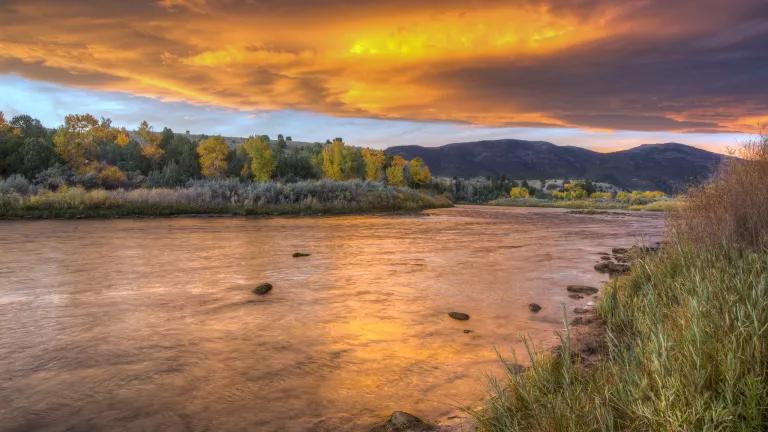I am not ashamed to admit it: I am middle-aged and love the “Harry Potter” series – so much so that I have been thinking hard about how to write a blog post about work and the new Harry Potter movie, which the family and I attended first thing Saturday morning. (It was awesome, and some unnamed members of the family may have gotten a little misty-eyed.) Anyhow, it turns out that there’s a pretty easy analog in the wizarding world to the world of clean water policy.
Potterphiles know well that the last installment of the series is largely about the heroes’ quest to find and destroy “horcruxes,” objects in which the evil (an adjective that really doesn’t do the guy justice) Lord Voldemort has hidden parts of his fractured soul. Voldemort did this to cheat death; it’s basically a way of hedging his bets by sprinkling fragments of evil around the world.
A similar thing is going on right now in the U.S. House of Representatives. The House is presently in the midst of developing appropriations bills to fund various governmental operations for fiscal year 2012, and anti-environmental members of Congress have divided up their agenda to essentially overturn the Clean Water Act into a series of “riders,” provisions that target particular pollution control initiatives and prohibit federal agencies from implementing them. These riders do not save the country money, but rather use the appropriations process instead of the usual legislative route to make major policy changes.
The pro-polluter crowd in the House seems to be hoping that the sheer volume of riders will mean that at least some of them will make it through the legislative process. These policy horcruxes attack virtually every clean water action that the Environmental Protection Agency has taken in the past couple years.
Here’s a run-down of the water pollution riders in the spending bill for EPA and the Department of the Interior. Before reading, you might want to sit down and grab a butterbeer – it’s a doozy of a list.
- Section 432 would keep the Office of Surface Mining within the Department of Interior from continuing work to revise regulations adopted in the waning days of the Bush administration that opened up streams to destructive and polluting practices associated with surface coal mining. The Obama administration, which has acknowledged both substantive and legal flaws with the Bush administration rule, actually needs to pick up the pace on this and develop a protective rule -- the last thing it needs is a directive to stop work.
- Section 433 seeks to shield mountaintop removal coal mining operations from EPA review by stopping EPA and the Corps of Engineers from continuing a process they put in place to scrutinize proposed mines. It would even suspend the use of an internal EPA memo that explains to agency personnel how the scientific evidence of the harms associated with mountaintop removal projects should be taken into account as EPA reviews permits issued to mine operators by the Corps of Engineers and states.
- Under section 435, unless and until Congress changes the law, EPA would be permanently prohibited from changing its rules defining what waters are protected by the Clean Water Act, or changing a pair of policy memoranda that EPA and the Corps issued during the Bush administration – memos that have had the real-world effect of denying Clean Water Act coverage to countless streams and wetlands. EPA and the Corps recently took critical first steps to overhaul their guidelines and update their regulations to better protect important waters, so this rider seeks to kill this good government initiative.
- Section 436 would restrict EPA from working further on regulations or requirements governing cooling water intake structures and thermal discharges from power plants. Although EPA has proposed a rule that is far too weak to protect the aquatic environment when it could’ve protected critical resources at a reasonable cost to industry with no adverse effects on electric reliability or consumer prices, the solution to the weak proposed rule is a strengthened rule rather than no rule at all.
- Section 438 would permanently change the Clean Water Act to exempt stormwater discharges from a host of logging-related sources from the law’s industrial permitting program. This provision would overturn a recent court decision requiring discharges from logging roads to be covered by pollution control permits. By allowing significant sediment-laden discharges from these operations to escape environmental review during the permitting process, the amendment would threaten drinking water supplies and native fish species.
- Section 439 attempts to stop EPA’s work on the development of a proposed rule to reform the national regulations governing runoff pollution from urban and suburban sites and stormwater systems. Nationwide, EPA estimates that “[u]rban stormwater is the primary source of water quality impairment [for] 13% of all rivers and streams[,] 18% of all lakes [and] 32% of all estuaries. . . .” At ocean and Great Lakes beaches in 2010, polluted runoff and stormwater caused or contributed to 8,712 beach closing/advisory days. Unfortunately, the rider would mandate that EPA halt work – which is well underway – to address these problems until 90 days after EPA submits a report to Congress about the reform effort. By doing so, it would blow up the agency’s current timetable to revise the rules by the end of next year.
- Title V of the bill is another permanent change to the Clean Water Act. It also amends the national pesticide law. It exempts pesticides from clean water permitting and strips EPA’s ability to protect our waters from pesticide contamination. This change has been included in stand-alone bills in both the House and Senate, about which my colleague Mae Wu has written extensively.
- An amendment offered by Rep. LaTourette (R-OH) could prohibit any EPA funds from going to any Great Lakes state that has set stronger ballast water pollution standards (either tougher numeric standards or faster implementation requirements) than weaker international standards or potentially weaker federal standards being developed by the U.S. Coast Guard. This amendment clearly applies to New York, which has been a leader in developing protective standards that will require the shipping industry to begin treating its ballast water before discharging it to eliminate invasive species threats. New York’s leadership has also been critical to driving the development of stronger regulations at the federal level. The language of this amendment could be read to strip all EPA funding from any Great Lakes state that has any requirements, including timelines, that are more stringent than federal or international requirements.
- An amendment offered by Rep. Diaz-Balart (R-FL) would keep EPA from implementing a program to clean up Florida waters that are plagued by harmful algae blooms, nasty slime that can produce harmful toxins and that can rob water bodies of the oxygen that fish and other critters need to live.
The House will vote on these provisions most likely next week. Here’s hoping that the friends of clean water in that chamber have some magic of their own to stop the attack.




